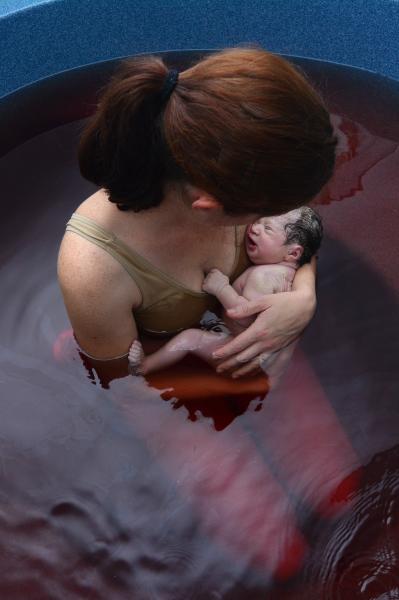Without fail, when the topic of water birth resurfaces in the media it is often done so irresponsibly. The latest recurrence doesn’t fail to disappoint.
Fox News Health just published an article “What it’s really like to have a home water birth” that was originally featured in Women’s Health. Though acknowledging the practice is “controversial,” it neglects to showcase that when negative outcomes take place they have ranged from significant to catastrophic. Among them is a case I published in Neoreviews of a near drowning of an infant via water birth— a few teaspoons inhaled at that age can cause pulmonary edema from drowning. But, I will get to that shortly.
Here, I will clarify the issue while asking you to consider whether you could live with the consequences of a water birth gone awry?! Keep that question at the forefront of your mind.
Most babies today are born healthy as a direct result of medical advances (eg. infection control measures). Maternal and infant mortality rates have dramatically improved due to such developments. This is wonderful news. Given the unpredictable scope of childbirth for all parties— mother and baby, why add a risk factor?
Delivery is a dynamic event. Uncomplicated and even low risk pregnancies are not guaranteed to occur without situations warranting intervention. Fortunately, we are more readily identifying problems before they arise, but unexpected issues are par for the course.
For example, recall the experience recently conveyed by late-night host Jimmy Kimmel where his son’s congenital heart defect was discovered postnatally (See Jimmy Kimmel Shares Newborn Son’s Heartfelt Health Crisis—I Share What Was Involved). This and other scenarios are not uncommon. In a hospital, the tools are present to stabilize mom and baby without delay. Delay can prompt further damage.
Delayed oxygen support or other procedures can take a toll on a newborn or mother. This is something to think about should you opt not to deliver in a hospital. Transporting to one carries risks, in particular in the unstable patient. For instance, if severe respiratory distress is an issue with the infant, then oxygen can be immediately administered in such a facility so the brain experiences less hypoxic injury—an irreversible condition whose extent is often not immediately known. As in life there are no certainties in delivery; but, in 2017 being in a position to have instant access to imaging modalities and life-saving treatments is a gift that did not always exist.
Advocates of “water birth” routinely use terms that are esoteric in an effort to confer a degree of professionalism and academic or scientific credibility. Whether referring to it as “hydrotherapy” or “aquatic birthing,” does not further its legitimacy. This is merely a marketing ploy.
Nor does invoking a woman’s right to return to her “physiologic” state. A woman retains this ability should she opt to deliver in a hospital or other setting. This notion that delivering in a hospital or facility with modern medical capabilities is mutually exclusive with a natural childbirth is unfounded. Obstetricians as a matter of routine explore this and other options with their eligible patients. When maternal or fetal health is at grave risk, then discussions must evolve to accommodate these considerations.
This recent article about home water birth describes two women’s reported positive experience. When one expressed concern over what could go wrong, she states “My midwife told me, ‘There are situations, and there are emergencies. If something goes wrong, we’d get you to the hospital.” The experience cost her $4000 plus $70 for the tub. Midwives can play a wonderful role in health care delivery, in general. They can provide an invaluable service in low risk populations desiring less interventions especially in hospital environments where an operating room is nearby and an obstetrician is at the ready. However, the practice of water birth is not one I endorse.
In the aforementioned statement, getting to a hospital depending upon the severity of the circumstance can make a profound difference in clinical course. Though many have had successful experiences with water birth, the issues that have occurred in infants include the following: Grade 2 & 3 Hypoxic Ischemic Encephalopathy (HIE) and perinatal asphyxia (the type of brain damage when an infant’s brain does not receive adequate oxygen and blood), aspiration, radiologic findings of fresh water drowning with pulmonary edema, respiratory distress, seizures as a result of very low sodium due to water intoxication, challenges of thermoregulation, Group B Strep (GBS) meningitis, snapped umbilical cords prompting blood loss with possible shock and need for transfusion, death etc. Oh, and there aren’t proven benefits.
Maternal risks include: loss of control of blood loss, decreased fetal monitoring, limited alternative analgesia, ineffective contractions, higher risk of infection especially with membrane rupture etc.
In Water Birth: To Breathe or Not To Breathe, I extensively address the current science and reported cases of adverse events from water birth. I also discuss the flawed data proponents cite. Additionally, I detail the recommendations of the American College of Obstetricians and Gynecologists and the American Academy of Pediatrics. Review that piece for a more comprehensive understanding of water birth.
“Controversial” does not do justice to the conversation.




